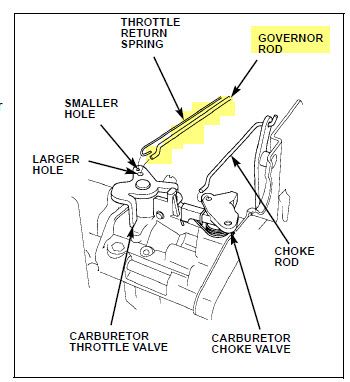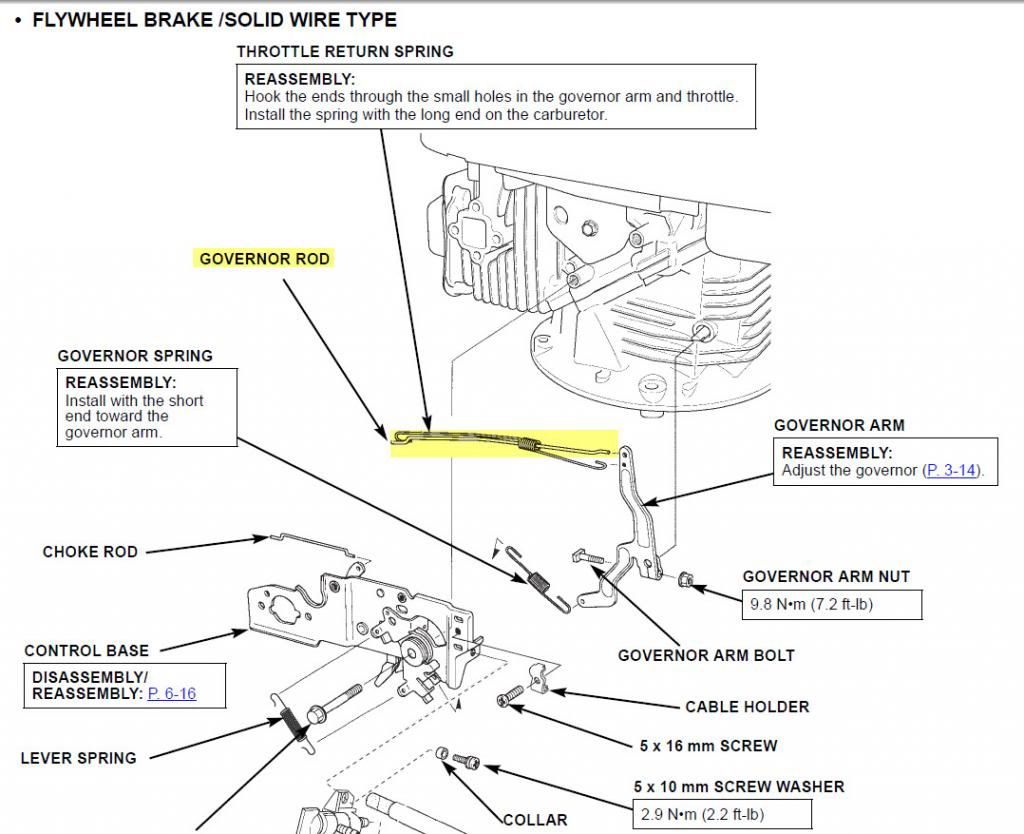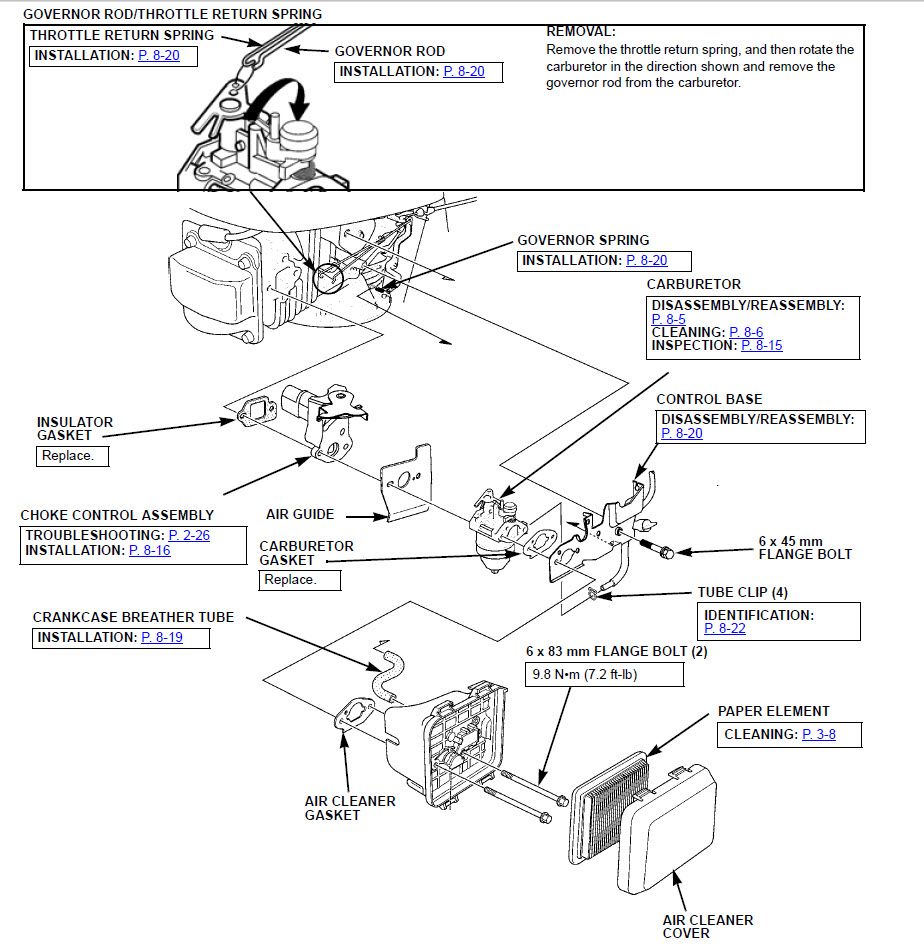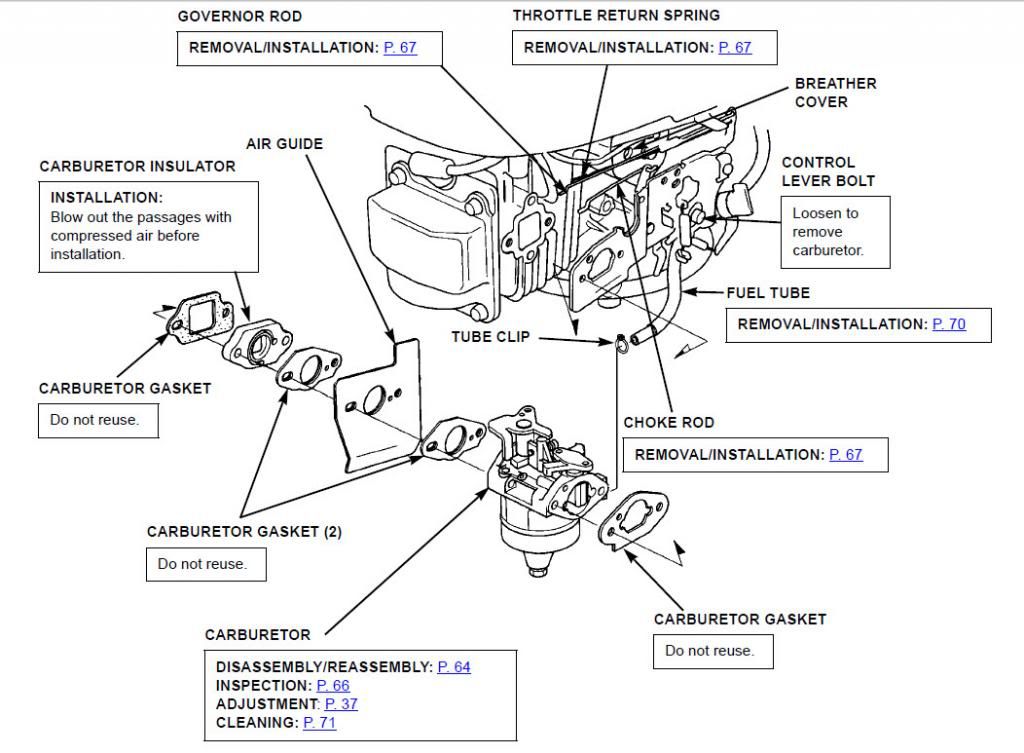You are using an out of date browser. It may not display this or other websites correctly.
You should upgrade or use an alternative browser.
You should upgrade or use an alternative browser.
Export thread
Honda carburetor replaced, but running too fast now
#1
M
minimor
M
minimor
My craftsman ez walk 917.377700 had carburetor issues, so I replaced it. I've know nothing, and the part came from sears without any information; when I replaced it and started it, it raced too fast, and I might have put the wire things from the throttle on wrong, but I can't find a diagram that shows how it should look. I switched the wires, but it still raced, and now it won't run at all. Is there a place to find a schematic that I could look at so I could fix it? :confused2:
I know nothing about motors, but I'm thinking it might be missing a wire that controls the speed, though I have been careful when working on it. I need to know if a part is missing, or how it should look. If anyone could help, I could post a picture of how it looks now, so one could say what I might have done wrong, or if something is missing. I would appreciate any information on this , or directions to where I could find information on honda motors or carburetors. Thanks. :smile:
I know nothing about motors, but I'm thinking it might be missing a wire that controls the speed, though I have been careful when working on it. I need to know if a part is missing, or how it should look. If anyone could help, I could post a picture of how it looks now, so one could say what I might have done wrong, or if something is missing. I would appreciate any information on this , or directions to where I could find information on honda motors or carburetors. Thanks. :smile:
#2

robert@honda
Honda make a number of different engines for Sears mowers. Depending on how Sears wanted the engine, it may have a fixed throttle, an adjustable throttle, automatic choke, manual choke, hard to say for sure. Your best bet is to check with Sears to confirm what options your mower has first. Next, on the side of the engine block is the ENGINE serial number, in the form of "GXXX-1234567" and if you'll share that with me, I can get you some basic engine information from Honda.
Does your mower have a throttle control? Does it have a manual choke? This will help with troubleshooting. Also, maybe some clear photos of the control linkage by the carburetor would help us see what you've got going on....
robert@honda
My craftsman ez walk 917.377700 had carburetor issues, so I replaced it. I've know nothing, and the part came from sears without any information; when I replaced it and started it, it raced too fast, and I might have put the wire things from the throttle on wrong, but I can't find a diagram that shows how it should look. I switched the wires, but it still raced, and now it won't run at all. Is there a place to find a schematic that I could look at so I could fix it? :confused2:
I know nothing about motors, but I'm thinking it might be missing a wire that controls the speed, though I have been careful when working on it. I need to know if a part is missing, or how it should look. If anyone could help, I could post a picture of how it looks now, so one could say what I might have done wrong, or if something is missing. I would appreciate any information on this , or directions to where I could find information on honda motors or carburetors. Thanks. :smile:
Honda make a number of different engines for Sears mowers. Depending on how Sears wanted the engine, it may have a fixed throttle, an adjustable throttle, automatic choke, manual choke, hard to say for sure. Your best bet is to check with Sears to confirm what options your mower has first. Next, on the side of the engine block is the ENGINE serial number, in the form of "GXXX-1234567" and if you'll share that with me, I can get you some basic engine information from Honda.
Does your mower have a throttle control? Does it have a manual choke? This will help with troubleshooting. Also, maybe some clear photos of the control linkage by the carburetor would help us see what you've got going on....
#3
M
minimor
Have attached photos of model and carburetor. It does have a throttle/choke control--I believe they're the same lever.



M
minimor
Honda make a number of different engines for Sears mowers. Depending on how Sears wanted the engine, it may have a fixed throttle, an adjustable throttle, automatic choke, manual choke, hard to say for sure. Your best bet is to check with Sears to confirm what options your mower has first. Next, on the side of the engine block is the ENGINE serial number, in the form of "GXXX-1234567" and if you'll share that with me, I can get you some basic engine information from Honda.
Does your mower have a throttle control? Does it have a manual choke? This will help with troubleshooting. Also, maybe some clear photos of the control linkage by the carburetor would help us see what you've got going on....
Have attached photos of model and carburetor. It does have a throttle/choke control--I believe they're the same lever.
Attachments
#4

robert@honda
Okay, one big thing I can see right off is there is a rod missing that connect the throttle control to the governor arm. The governor is what regulates the engine speed, so sure, no doubt the engine is racing without that rod in place. Here are two drawings showing the details:


robert@honda
Have attached photos of model and carburetor. It does have a throttle/choke control--I believe they're the same lever.
Okay, one big thing I can see right off is there is a rod missing that connect the throttle control to the governor arm. The governor is what regulates the engine speed, so sure, no doubt the engine is racing without that rod in place. Here are two drawings showing the details:


#5

scott47429
scott47429
looks like you have the choke rod and the gov. rod both in the choke you need to move the gov. rod over to the throttle to the larger hole with the spring and move the choke rod to the upper hole and all should work good
#6
M
minimor
M
minimor
Thank you, robert@honda, for the diagrams. My neighbor thought maybe a wire was missing, but I didn't remember seeing any when I took it apart, so I wasn't sure what was amiss. I will use these and try to fix it. I greatly appreciate your taking the time to look these up and send them._It's grueling hot here today, but I will work on it early tomorrow and get back with the results.
#7

robert@honda
I live in Hotlanta, so I used to think I knew what hot was...then I had to travel to Harlingen....in August
robert@honda
Th._It's grueling hot here today, but I will work on it early tomorrow and get back with the results.
I live in Hotlanta, so I used to think I knew what hot was...then I had to travel to Harlingen....in August
#8
M
minimor
M
minimor
Rather like being a cooked goose, isn't it? (Of course, I've never been officially cooked, but it sure feels like it many days!) Harlingen area is even worse than Houston, and the weather is not pleasant except in winter. But so far the mornings are cool enough to work outside. Thanks again for the info and diagrams.
#9
M
minimor
Life is too busy!
I found that the hookup was indeed wrong, and following the diagrams you put online, I corrected them.
Then when I tried to start it, the starter broke: the spring in it broke. Now it is replaced, and it starts beautifully, but then it stops. Now I have reached the limit of my small experience. It has gas, the new cord and spring aids in a quick and easy start, but I need it to run, of course, so I can cut my now hay field/yard.
I was unsure of the order when I put the carberator in, because an neighbor tried to help and took it apart and took all the gaskets out saying they weren't needed. Also, I couldn't remember where the metal heat deflector went. But I am assuming that since it starts, the order I put it in must have been fairly close, as it does start(Actually, I went by the structure of the holes in the gaskets, but wasn't sure where the rubber looking one went, as opposed to the paper like ones.) Is there a place to find the order of the pieces and the correct placement of the gaskets that go in between the parts?
M
minimor
I live in Hotlanta, so I used to think I knew what hot was...then I had to travel to Harlingen....in August
Life is too busy!
I found that the hookup was indeed wrong, and following the diagrams you put online, I corrected them.
Then when I tried to start it, the starter broke: the spring in it broke. Now it is replaced, and it starts beautifully, but then it stops. Now I have reached the limit of my small experience. It has gas, the new cord and spring aids in a quick and easy start, but I need it to run, of course, so I can cut my now hay field/yard.
I was unsure of the order when I put the carberator in, because an neighbor tried to help and took it apart and took all the gaskets out saying they weren't needed. Also, I couldn't remember where the metal heat deflector went. But I am assuming that since it starts, the order I put it in must have been fairly close, as it does start(Actually, I went by the structure of the holes in the gaskets, but wasn't sure where the rubber looking one went, as opposed to the paper like ones.) Is there a place to find the order of the pieces and the correct placement of the gaskets that go in between the parts?
#10

robert@honda
robert@honda
This should be pretty close:

Get the two long bolts good and snug (not "gorilla tight") to prevent vacuum leaks around the gaskets...

Get the two long bolts good and snug (not "gorilla tight") to prevent vacuum leaks around the gaskets...
#11

EngineMan
Next time put a camera to it before the spanner.
EngineMan
My craftsman ez walk 917.377700 had carburetor issues, so I replaced it. I've know nothing,:
Next time put a camera to it before the spanner.
#12
M
minimor
M
minimor
This should be pretty close:
Thanks, Robert , my internet was down since I yesterday(just after my reply), so I just got your reply. Thanks, and blessings to you. I do so appreciate your willingness to help out. Sorrowfully, I think I have everything different, which may be why it won't run. When I went for gaskets, they insisted I needed seven different ones. I think they are more into making bucks then in integrity. It poured yesterday and this morning, so I my grass is higher and hopefully I won't have to hire a goat or horse. But when it runs, the mower is one great machine, so I guess if I reconstruct the order, it might run again. Thanks. Let you know tomorrow if this ends the saga.
#13
M
minimor
M
minimor
This should be pretty close:
This looks similar to mine, but the choke assembly and the carburater are one(as it shows in the first diagram you gave me), so I am not sure where the air guide should go. the new carburater appears to be identical to the old one(which I just compared it to), and I don't remember where the order(I learned to copy it all down as I take it apart; it seemed so logical, but no wit doesn't).
Do you know what it should go? Also, is the insulator gasket the one that is metal with rubber or something black coating it?
Thirdly, it says that the carburater is set at the factory, but it does have screws that appear to move, so is that for regulating the speed?
Again, I do appreciate the information; wish I had the funds to have the lawn mowed, or the thing fixed. Thanks.
#14
M
minimor
You are so right, Scott! Wish I had done that, and I will in the future. thanks.!
M
minimor
Next time put a camera to it before the spanner.
You are so right, Scott! Wish I had done that, and I will in the future. thanks.!
#15

robert@honda
To be absolutely sure which specific Honda engine is on your Sears mower, I need the ENGINE serial number off the side of the engine block. It starts with a "G" the followed by 3 or 4 letters, and then 7 digits, liked "GXXXX-1234567"
Here's the best I can do based on a "generic" GCV160 mower engine:

robert@honda
This looks similar to mine, but the choke assembly and the carburater are one(as it shows in the first diagram you gave me), so I am not sure where the air guide should go. the new carburater appears to be identical to the old one(which I just compared it to), and I don't remember where the order(I learned to copy it all down as I take it apart; it seemed so logical, but no wit doesn't).
To be absolutely sure which specific Honda engine is on your Sears mower, I need the ENGINE serial number off the side of the engine block. It starts with a "G" the followed by 3 or 4 letters, and then 7 digits, liked "GXXXX-1234567"
Here's the best I can do based on a "generic" GCV160 mower engine:

#16
M
minimor
M
minimor
To be absolutely sure which specific Honda engine is on your Sears mower, I need the ENGINE serial number off the side of the engine block. It starts with a "G" the followed by 3 or 4 letters, and then 7 digits, liked "GXXXX-1234567"
I don't know how to reply without a quote; have none.
Thanks for the diagram. Now I have checked the order and all is correct, but the machine acts like it isn't getting any gas, and there is gas in the tank. (I did take off the air filter cover and tried starting it without that, but that didn't work.)
I was told/read that the carburater comes factory fixed for levels, but is there a way to let it receive more gas?
I noticed that there are screws on the top, but I don't know what they are for, so haven't fooled with them. I so need to mow my mile high grass. thanks.
#17
B
bbgambini2
B
bbgambini2
Hello Robert from Honda,
I'm also having problems with my GCV160 starting and have taken carb off and cleaned it now putting it back altogether. looking at your diagram and not sure how the choke control assembly , p. 2-26, p. 8-16 goes back on. do you have diagrams of this?
Thanks,
Brandon
I'm also having problems with my GCV160 starting and have taken carb off and cleaned it now putting it back altogether. looking at your diagram and not sure how the choke control assembly , p. 2-26, p. 8-16 goes back on. do you have diagrams of this?
Thanks,
Brandon
#18

robert@honda
Brandon, there are dozens of "flavors" of GCV160 engines, so get me the full serial number off the side of yours; it's in the form of GXXX-1234567 or GXXXX-1234567 and might be "stenciled" into the side of the engine block and might need a flashlight to read it...
robert@honda
Hello Robert from Honda,
I'm also having problems with my GCV160 starting and have taken carb off and cleaned it now putting it back altogether. looking at your diagram and not sure how the choke control assembly , p. 2-26, p. 8-16 goes back on. do you have diagrams of this?
Thanks,
Brandon
Brandon, there are dozens of "flavors" of GCV160 engines, so get me the full serial number off the side of yours; it's in the form of GXXX-1234567 or GXXXX-1234567 and might be "stenciled" into the side of the engine block and might need a flashlight to read it...
#19
D
ddefalco
Just sort of stumbled across this forum while trying to hunt down information on the Honda GCV160 S3A
engine's carburetor, as I've been having some problems with mine recently (this is actually on a Troy-Bilt
mower, but that's immaterial). I'm particularly interested in the diagram Robert posted, as it appears to
have come from a shop manual or similar publication (I noticed the page number references for cleaning,
adjustment and disassembly/reassembly details in a few places).
Is the manual that the diagram came from available to the general public somewhere? Can it be accessed
online? It looks as though it would be a very useful piece of documentation.
Does Honda (or a 3rd-party aftermarket manufacturer) offer a "kit" for this carburetor, similar to kits
that one can buy for automobile carburetors (float, jet(s), gaskets, etc.)? The mower that this carburetor
came from was allowed to sit through 2 seasons without being properly prepped for storage, and when I
initially disassembled it, it was pretty gunked up. It's been well cleaned and reassembled, but no gas is
passing through to the engine intake, so I'm thinking a kit is the way to go (short of procuring a completely
new carburetor). For what it's worth, the S/N of the engine is GJAEA-5156324, and is type S3A.
ANY and ALL comments welcome!
D
ddefalco
To be absolutely sure which specific Honda engine is on your Sears mower, I need the ENGINE serial number off the side of the engine block. It starts with a "G" the followed by 3 or 4 letters, and then 7 digits, liked "GXXXX-1234567"
Here's the best I can do based on a "generic" GCV160 mower engine:

Just sort of stumbled across this forum while trying to hunt down information on the Honda GCV160 S3A
engine's carburetor, as I've been having some problems with mine recently (this is actually on a Troy-Bilt
mower, but that's immaterial). I'm particularly interested in the diagram Robert posted, as it appears to
have come from a shop manual or similar publication (I noticed the page number references for cleaning,
adjustment and disassembly/reassembly details in a few places).
Is the manual that the diagram came from available to the general public somewhere? Can it be accessed
online? It looks as though it would be a very useful piece of documentation.
Does Honda (or a 3rd-party aftermarket manufacturer) offer a "kit" for this carburetor, similar to kits
that one can buy for automobile carburetors (float, jet(s), gaskets, etc.)? The mower that this carburetor
came from was allowed to sit through 2 seasons without being properly prepped for storage, and when I
initially disassembled it, it was pretty gunked up. It's been well cleaned and reassembled, but no gas is
passing through to the engine intake, so I'm thinking a kit is the way to go (short of procuring a completely
new carburetor). For what it's worth, the S/N of the engine is GJAEA-5156324, and is type S3A.
ANY and ALL comments welcome!
#20

robert@honda
Honda sells a GCV160 shop manual on both eBay and Amazon, free shipping. Links:
GCV160 Shop Manual on Amazon
GCV160 Shop Manual on eBay
Honda doesn't make a carb kit, but you can order individual carb parts. Many dealers offer on-line parts catalogs you can browse. Try Boats.net - New and Used Boats for Sale, Outboard Boat Motors, and Discount Outboard Boat Parts for example. Better still, just buy a whole new carburetor. For your engine, it's Honda Part Number 16100-Z0L-853, list price only $13.34. A whole lot less hassle and time to simply replace vs. trying to perfectly clean and reassemble a crummy old carburetor. I'd also suggest you replace the four gaskets at the same time, and pay close attention to how everything goes back together. It's easy to get a gasket or space/guide on backwards, and the engine will either not start or surge/run poorly. The Shop Manual is worth every nickle in this regard.
robert@honda
Is the manual that the diagram came from available to the general public somewhere? Can it be accessed
online? It looks as though it would be a very useful piece of documentation.
Does Honda (or a 3rd-party aftermarket manufacturer) offer a "kit" for this carburetor, similar to kits
that one can buy for automobile carburetors (float, jet(s), gaskets, etc.)? The mower that this carburetor
came from was allowed to sit through 2 seasons without being properly prepped for storage, and when I
initially disassembled it, it was pretty gunked up. It's been well cleaned and reassembled, but no gas is
passing through to the engine intake, so I'm thinking a kit is the way to go (short of procuring a completely
new carburetor). For what it's worth, the S/N of the engine is GJAEA-5156324, and is type S3A.
Honda sells a GCV160 shop manual on both eBay and Amazon, free shipping. Links:
GCV160 Shop Manual on Amazon
GCV160 Shop Manual on eBay
Honda doesn't make a carb kit, but you can order individual carb parts. Many dealers offer on-line parts catalogs you can browse. Try Boats.net - New and Used Boats for Sale, Outboard Boat Motors, and Discount Outboard Boat Parts for example. Better still, just buy a whole new carburetor. For your engine, it's Honda Part Number 16100-Z0L-853, list price only $13.34. A whole lot less hassle and time to simply replace vs. trying to perfectly clean and reassemble a crummy old carburetor. I'd also suggest you replace the four gaskets at the same time, and pay close attention to how everything goes back together. It's easy to get a gasket or space/guide on backwards, and the engine will either not start or surge/run poorly. The Shop Manual is worth every nickle in this regard.
